Exciton fission enhanced silicon solar cell
IF 35.4
1区 材料科学
Q1 CHEMISTRY, PHYSICAL
引用次数: 0
Abstract
While silicon solar cells dominate global photovoltaic energy production, their continued improvement is hindered by the single-junction limit. One potential solution is to use molecular singlet exciton fission to generate two electrons from each absorbed high-energy photon. We demonstrate that the long-standing challenge of coupling molecular excited states to silicon solar cells can be overcome using sequential charge transfer. Combining zinc phthalocyanine, aluminum oxide, and a shallow junction crystalline silicon microwire solar cell, the peak charge generation efficiency per photon absorbed in tetracene is (138% ± 6%), comfortably surpassing the quantum efficiency limit for conventional silicon solar cells and establishing a new, scalable approach to low-cost, high-efficiency photovoltaics.


激子裂变增强硅太阳能电池
虽然硅太阳能电池在全球光伏能源生产中占主导地位,但它们的持续改进受到单结限制的阻碍。一个潜在的解决方案是利用分子单线态激子裂变从每个吸收的高能光子中产生两个电子。我们证明了将分子激发态耦合到硅太阳能电池的长期挑战可以通过顺序电荷转移来克服。结合酞菁锌、氧化铝和浅结晶体硅微线太阳能电池,四烯吸收的每光子峰值电荷产生效率为(138%±6%),轻松超越了传统硅太阳能电池的量子效率极限,并建立了一种新的、可扩展的低成本、高效率光伏发电方法。
本文章由计算机程序翻译,如有差异,请以英文原文为准。
求助全文
约1分钟内获得全文
求助全文
来源期刊

Joule
Energy-General Energy
CiteScore
53.10
自引率
2.00%
发文量
198
期刊介绍:
Joule is a sister journal to Cell that focuses on research, analysis, and ideas related to sustainable energy. It aims to address the global challenge of the need for more sustainable energy solutions. Joule is a forward-looking journal that bridges disciplines and scales of energy research. It connects researchers and analysts working on scientific, technical, economic, policy, and social challenges related to sustainable energy. The journal covers a wide range of energy research, from fundamental laboratory studies on energy conversion and storage to global-level analysis. Joule aims to highlight and amplify the implications, challenges, and opportunities of novel energy research for different groups in the field.
 求助内容:
求助内容: 应助结果提醒方式:
应助结果提醒方式:


